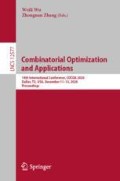Abstract
This paper quantitatively analyzes the inspection strategy (which arriving ships are selected for inspection) for on-board fuel sampling considering limited inspection capacity and ships’ violation behaviors. By establishing a semi-random input model and proposing the corresponding algorithm, the optimal inspection strategy is obtained. Furthermore, the impacts of related factors on the optimal inspection strategy are analyzed. The results show that compared to randomly select ships, the method proposed in our study can determine a more reasonable inspection strategy.
Access this chapter
Tax calculation will be finalised at checkout
Purchases are for personal use only
Notes
- 1.
According to the simulation, the numerator and denominator of c have the same order of magnitude. The range of c and \( \sigma \) are [0.6, 1.8] and 0.16, respectively. In addition, the determination of non-compliant ships is mainly affected by the relative value of b and has little relationship with the absolute value b. Therefore, the establishment of b is relatively reasonable.
References
Tichavska, M., Tovar, B., Gritsenko, D., Johansson, L., Jalkanen, J.P.: Air emissions from ships in port: does regulation make a difference? Transp. Policy 75, 128–140 (2017)
Perera, L.P., Mo, B.: Emission control based energy efficiency measures in ship operations. Appl. Ocean Res. 60, 29–46 (2016)
Li, L., Gao, S., Yang, W., Xiong, X.: Ship’s response strategy to emission control areas: from the perspective of sailing pattern optimization and evasion strategy selection. Transp. Res. Part E: Logist. Transp. Rev. 133, 101835 (2020)
Liu, Y., Wang, Z.: Game simulation of policy regulation evolution in emission control area based on system dynamics. In: 2019 3rd Scientific Conference on Mechatronics Engineering and Computer Science, pp. 384–388. Francis Academic Press (2019)
Jiang, B., Xue, H., Li, J.: Study on regulation strategies of China’s ship emission control area (ECA) based on evolutionary game (in Chinese). Logistic Sci-Tech 7, 70–74 (2018)
EMSA: Sulphur Inspection Guidance. European Maritime Safety Agency (2018)
Ronen, D.: The effect of oil price on the optimal speed of ships. J. Oper. Res. Soc. 33, 1035–1040 (2017)
Du, Y., Chen, Q., Quan, X., Long, L., Fung, R.Y.K.: Berth allocation considering fuel consumption and vessel emissions. Transp. Res. Part E: Logist. Transp. Rev. 47, 1021–1037 (2011)
IMO: Reduction of GHG emissions from ships, third IMO GHG Study 2014 (2014)
Wang, S., Meng, Q.: Sailing speed optimization for container ships in a liner shipping network. Transp. Res. Part E: Logist. Transp. Rev. 48, 701–714 (2012)
Psaraftis, H.N., Kontovas, C.A.: Speed models for energy-efficient maritime transportation: a taxonomy and survey. Transp. Res. Part C: Emerg. Technol. 26, 331–351 (2013)
Dulebenets, M.A.: Advantages and disadvantages from enforcing emission restrictions within emission control areas. Marit. Bus. Rev. 1, 107–132 (2016)
Phillip, A.B.: EPA penalty policy for violations by ships of the sulfur in fuel standard and related provisions. Environmental Protection Agency, United Sates (2015)
Kim, S., Pasupathy, R., Henderson, S.G.: A guide to sample average approximation. In: Fu, M.C. (ed.) Handbook of Simulation Optimization. ISORMS, vol. 216, pp. 207–243. Springer, New York (2015). https://doi.org/10.1007/978-1-4939-1384-8_8
Marine bunker exchange. http://www.mabux.com
IMO: Third IMO GHG Study 2014 – Final Report. International Maritime Organization (2015)
CEC: Best Available Technology for Air Pollution Control: Analysis Guidance and Case Studies for North America. Commission for Environmental Cooperation of North America (2005)
Nazha, N.: North American emission control area, canada’s compliance and enforcement program. In: 5th PPCAC Conference, Transport Canada (2018)
Olaniyi, E.O., Prause, G.: Seca regulatory impact assessment: administrative burden costs in the baltic sea region. Transp. Telecommun. J. 20, 62–73 (2019)
European Union. https://eur-lex.europa.eu/eli/dec_impl/2015/253/oj
Funding
This work was supported by the National Natural Science Foundation of China (11991022).
Author information
Authors and Affiliations
Corresponding author
Editor information
Editors and Affiliations
Rights and permissions
Copyright information
© 2020 Springer Nature Switzerland AG
About this paper
Cite this paper
Li, L., Gao, S., Yang, W. (2020). Inspection Strategy for On-board Fuel Sampling Within Emission Control Areas. In: Wu, W., Zhang, Z. (eds) Combinatorial Optimization and Applications. COCOA 2020. Lecture Notes in Computer Science(), vol 12577. Springer, Cham. https://doi.org/10.1007/978-3-030-64843-5_41
Download citation
DOI: https://doi.org/10.1007/978-3-030-64843-5_41
Published:
Publisher Name: Springer, Cham
Print ISBN: 978-3-030-64842-8
Online ISBN: 978-3-030-64843-5
eBook Packages: Computer ScienceComputer Science (R0)

